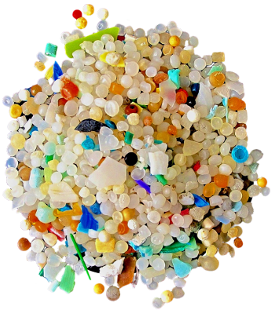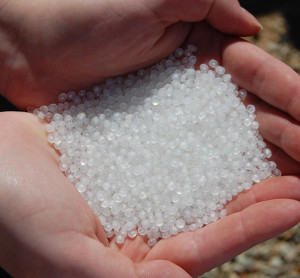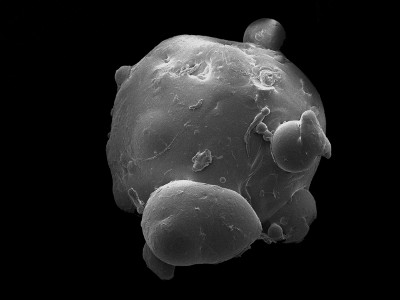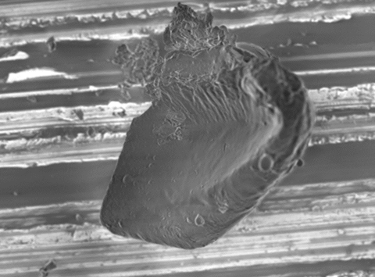Microplastics

Microplastics are polymer fragments measuring less than 5 mm. However, they are often considerably smaller (< 50 um). These smaller fragments, which may be invisible to the naked eye, can fall into the submicrometer range (nanoplastics).
Microplastic Products

A handful of commercially produced microplastic waste (CC by 2.0).
Many consumer products intentionally contain microplastics, when minor abrasive and exfolliative properties can be useful. Toothpastes, facial scrubs, cosmetics, and hand soaps frequently use microplastics for this reason. Secondary microplastics, on the other hand, are generated from the degradation of larger plastic objects including water bottles, synthetic clothing fibers, tires, and plastic bags. Ultimately, many of these primary and secondary microflakes, microbeads, and microfibers make their way as pollutants into oceans, fresh water sources, sand, and soil. As a result, these microscopic plastics turn up in a wide range of products including bottled drinking water, alcohol, seafood, and honey.
Laboratory Analysis of Microplastics

A plastic microbead (about .5 mm wide) extraxted from a facewash product. Photo taken by SEM. (photo by Andrew Watts CC by 2.0)
With an expertise in small particle analysis, Microtrace has the capabilities, methods, and experience to isolate, analyze, and identify these particles. These analyses support investigations from both manufacturing and environmental science perspectives. From larger, millimeter-sized particles, to particles in the 500-50 micrometer range, down to sub-visible microparticles (1-50 µm), and even nanoplastics (nanoparticles), Microtrace has the expertise to support nearly any analyses involving microplastics in its ISO 17025 accredited laboratory.
A publication by Microtrace staff on microplastic and nanoplastic particles generated by 3-D printers illustrates some of the ways in which these particles can be analyzed (Brinsko-Beckert et al., 2020). Another related article on the prevalence and analysis of printer toners in indoor environments by the Microtrace staff illustrates the ways in which color, polymer identification, pigment identification, micromorphology, and nanotextures can be used to classify, identify, and source these minute polymers (White, et al., 2020).
Whether the analysis requires processing large numbers of samples or analyses focused on a single particle, Microtrace has the capabilities, experience, and expertise to find, identify, and place constraints on the source microparticles.
In some instances, the first step of an investigation involves the isolation of microplastics from a matrix. This matrix may include natural waters or a beverage, in which case sieving or filtration may be the optimal method for isolation. In other cases, more advanced isolation methods are required, which may include locating and separating microplastics from food, meat, soil, or commercial products. Microtrace has a great deal of experience in isolating minute particles from a wide range of sample matrices.

Microplastic particle produced by a 3D printer (Microtrace).
Light microscopy is a primary tool for locating and classifying microparticles, and advanced image analysis methods can be used to provide information about the size, morphology, shape, and particle size distribution for a population of particles. Microtrace maintains a suite of other microanalytical instrumentation to characterize these minute particles to the extent necessary. Whether this includes an identification of the polymer by infrared microspectroscopy (FTIR) or Raman microspectrophotometry (RMP), elemental analysis by scanning electron microscopy with energy dispersive x-ray spectroscopy (SEM/EDS), colorant (pigment or dye) identification, or trace metal analysis by micro-x-ray fluorescence spectrophotometry (micro-XRF), Microtrace can provide the needed level of testing. For some particles, it is possible to document and analyze the degradation process occurring within a single particle. Our experts can use chemical mapping or other probes to accomplish this.
While many laboratories have similar instrumentation, few laboratories combine the practical expertise of small particle manipulation and advanced theoretical knowledge of instrumentation, polymeric materials, and industrial processes. With a client-base that spans applied research organizations, criminal and civil forensic casework, and environmental laboratories, Microtrace has developed an international reputation for providing transparent data and direct answers to our clients’ questions. Our results, testimony, and expert witness services have withstood both scientific peer review and legal scrutiny in state, federal, military, and international courts.
Contact us to discuss your project inquiry with a member of our scientific staff.
References
Brinsko-Beckert, Kelly and Palenik, Christopher S. “The Analysis of 3D Printer Dust for Forensic Applications” JFS, (upcoming September 2020) DOI: 10.1111/1556-4029.14486.
White, Katie M., and Palenik, Christopher S. “Toner Particles as Forensic Evidence: Microanalytical Characterization of Known Toner and Recognition of Toner in Environmental Samples” JFS (upcoming 2020).
Palenik, Samuel J. “The determination of Geographical Origin of Dust Samples.” The Particle
Atlas, Vol. 5, (Ann Arbor Publishers, 1979).
How May We Help You?
Contact usto discuss your project in more detail.







